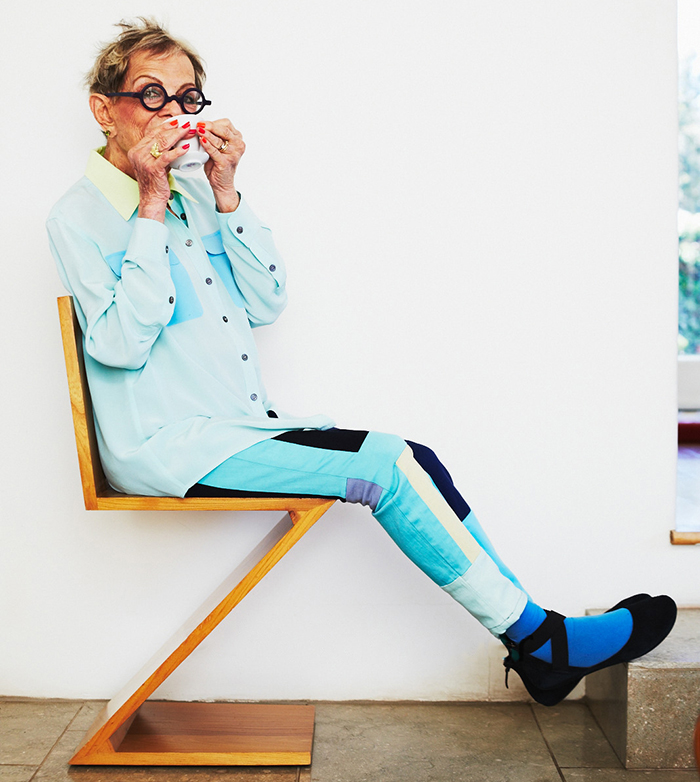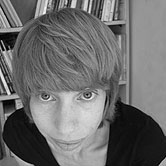
Deborah Sussman, June 2014 (Photographer: Jiro Schneider)
The death this week of Deborah Sussman, who passed away in Los Angeles at age 83, is notable in part because she was a woman able to carve out a vibrant and successful career in a field traditionally dominated by men. Sussman lived long enough to see her career receive critical attention, most recently as the subject of a retrospective exhibition, Deborah Sussman Loves LA, held last winter at Los Angeles’ Woodbury University Hollywood Gallery.
That love is reciprocated. As the show’s title suggests, she is rapidly becoming canonized in Southern California; but this Los Angeles love story often overshadows one of the key aspects of Sussman’s career — her rise and influence as a woman working in the male-dominated world of postwar design.
For all the Los Angeles boosterism, Sussman’s roots lie in Brooklyn, where she was born in 1931. From an early age, Sussman was pulled between her early desire to become an actress and her fascination with art and design. Although educated at Bard College — where she studied painting and acted in student productions — she was drawn to the eclectically avant-garde milieu of Black Mountain College where she spent a summer studying. But Sussman’s real awakening came during her junior year, when she decided to transfer her studies to the “New Bauhaus” at the Illinois Institute of Technology: what began as a short break from Bard grew into a three-year stay.
At IIT, Sussman accumulated mentors, including the Swiss trained Hugo Weber (1918-1971) and the visionary architect and engineer Konrad Wachsmann (1901-1980). Skilled at drawing and gifted at model-making, Sussman stood out from her peers and was soon recruited by Charles Eames, who visited the school in 1953. For Sussman, the opportunity to work with the Eamses was “like being told you’re going to heaven and you’re to live there.”
Arriving without commitments, responsibilities, dependents or emotional ties, Sussman was thrust into a variety of roles, ranging from graphic designer to filmmaker and, ultimately, to the confidante of Ray Eames. Indeed, they fluidly moved between appointed work roles and, in later years, Sussman made a point of identifying for scholars the contributions of Ray Eames to the team’s work. Sussman’s long tenure with the Eameses undoubtedly helped her subsequent career, when she set up her own design studio. “Working at the Eames office,” she would later note, “was like getting a certification of value.” Perhaps ironically, however, those ties now obscure Sussman’s own early work; like her good friend Ray, Sussman found her own designs often subsumed under the larger Eames studio label.
Indeed, after two lengthy stints working with the Eameses — first from 1953 to 1957 and again from 1961 to 1967 — Sussman grew to a greater maturity, taking on independent work and officially leaving the Eames studio to establish Sussman and Company in 1968. She would later become a pioneer in environmental design, a move considerably aided by collaboration with her husband, the architect Paul Prejza. Heading the new firm Sussman/Prezja also brought her into more contact with the male-dominated architecture and design establishment, what she called “the old boys club of designers in Los Angeles.” To Sussman it seemed like “they got all the jobs. They did all the work. They were the elite.”
Perhaps Deborah Sussman’s best-known work — for the 1984 Los Angeles Olympics — is often associated with the California New Wave movement, but it also thrust her into an uneasy leadership role. As she recalls, being in charge of some 150 designers — most of whom were men — required subtle but firm leadership. “The male mafia” with whom she worked were dubious, and she remembered well an early “presentation that I made to everybody … and I had selected this palette of color and here I am this little female telling them what colors they had to use, and they were all sort of stone-faced … And they said, but where’s the gray? We need gray with those colors.” But Sussman’s colorful vision for the Olympics would prevail, and her image for the city helped seal Los Angeles’s own design identity. For this work and for so much more, she will be greatly missed and long remembered — a pioneer in the fullest sense.


Comments [6]
08.23.14
02:01
08.24.14
11:22
08.27.14
07:59
On the one hand, Deborah Sussman found what she was interested in and then pursued it bravely. Although she studied painting and acted in student productions earlier at Bard College, she still chosed to transfer her studies to the New Bauhaus at the Illinois Institute of Technology when she found that she was really attracted by the eclectically avant-garde milieu of Black Mountain College. As she just intended to studied there for a short time. She even stayed there for three years because she liked it. I think there are a lot of young students at present studying what they do not like. Either they do not know what they are really interested in or they are afraid to make their interests to be their major for the concerns about the employment situation or other things.But if you do not enjoy your work or dislike it , it would be difficult for you to be outstanding in that field.
On the other hand, as there is an old saying in China, lucky is also a kind of strength. Of course, lucky is never the decisive factor.For us, we need to grasp the opportunities whenever we find them.At IIT, Sussman met some good mentors. I think it is really important for her career. Working with the Eamses is an essential experience in her career, which also make her more confident about herself. The reason why she could be stand out from her peers was that she was skilled at drawing and gifted at model-making. So It tell us that opportunities are always for whom have been prepared.
09.02.14
03:30
09.03.14
07:45
While searching for an item in my plan chest this morning I came across a large folded piece of paper which you had pinned to my Olympic design HQ studio wall some 31 years ago!
It was a drawing of a five-ringed pair of spectacles emulating my poster “Looking at the Look for the '84 Olympics”, which announced my talk to the Art Directors Club of Los Angeles.
Your drawing accompanied the following message: “Hi Arnold! thanks for the pooster — see you soon? we're moving in sort of — Deborah Wed aft”. Each of the double “oo”s had spectacle arms drawn on them!
The note provided me with a hint of your great sense of wit, a precursor perhaps to the recent wonderful photograph of you wearing your numerous pairs of spectacles!
Your impending move into the facility signaling that you were soon to present to the world your unique look for the '84 Olympic Games.
Just a few weeks ago Isolde and I attended the 30th anniversary celebration of the 1984 Olympic Games. Your absence was sorely felt as you were without a doubt a major contributor to the success of that Olympiad.
It was always an education and such fun working alongside you and Paul. Coming from a background of working in black & white television, I could not fail to be impressed by your acute sense of color and style.
I fondly recall the day you diplomatically changed the name of your Olympic Mariachi color palate to “Festive Federalism”. I saw you as a 21st century Mondrian, a mistress of color.
I further recall the time you and Paul engaged me as your design consultant on London's Canary Wharf project and how I marveled at your confidence and skill of presentation.
Somehow finding your note today prompted me to turn to my copy of the book “AGI graphic design since 1950”. As I opened its pages a bookmark fell out, its design included a photograph of a field of corn, and written in the sky was “from Deborah”. As the film reminds us, “If you build it they will come”, and they did, and so when you were elected in 1985 to AGI you had finally broken through the barrier for women to be internationally recognized in design in an organization which was traditionally a male-dominated profession. When I was elected in 1974 there had only been two women members. Through your many achievements in design, your legacy is now carved in stone.
Dear Deborah, We shall miss your company at the AGI congresses, at those festive July Fourths that we spent together with mutual friends in Santa Barbara, and the Oscar viewing parties at your home.
Our sadness for your passing is tempered with so many fond memories of the times that we spent together and of your colorful life.
Isolde and I will ever remain among your enduring fans.
Much love,
Arnold
09.08.14
07:40